This is the second part of my review of Factorio: Space Age, covering the planets. This will have more spoilers than the previous section, but also include more cohesive thoughts on the expansion as a whole.
Vulcanus
Once you’ve built a spaceship, you have a choice of three planets to go to, and you can do them in any order you’d like. Each planet comes with its own researchable rewards, which require you to build up a base on the planet capable of making a science pack and shipping it into space (or alternately, remake all sciences on the planet, but this is stupid and pointless given what lies further down the tech tree).
I chose Vulcanus first. There are five resources here, three of which can’t be found anywhere else: coal, sulfuric acid, calcite, tungsten ore, and lava. Lava gets used to make anything having to do with copper and iron using the foundry, which is most of the things in Factorio. Sulfuric acid gets used with calcite to make water, which is one of the notable things missing from Vulcanus, along with oil. Plastic requires a long chain to make: coal liquefaction into heavy oil into light oil into petroleum into plastic. Because rockets require plastic twice (LDS and blue chips), you eventually need to set up a fairly sizeable build for this.
I didn’t find any of this to be too interesting. Infinite resources are at least different, but there was nothing that fundamentally changed how I view the game, and I ended up setting up a bus with more fluids than usual, mostly making on-site plates, pipes, steel, etc. The art for it is cool, and impassable lava is at least a little constraining, but I didn’t feel like it was all that great.
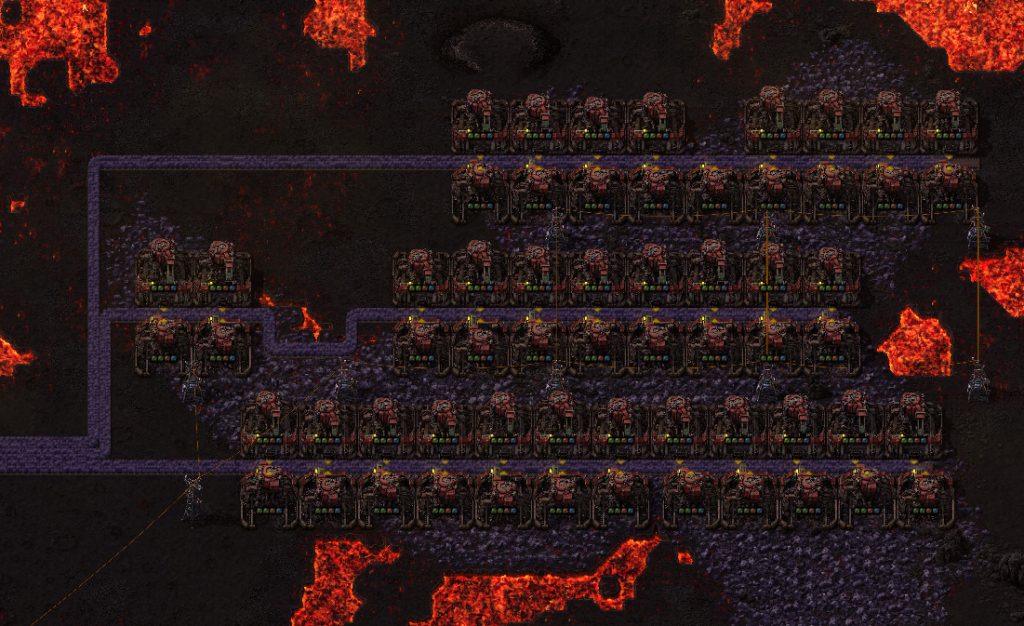
Tungsten ore is the main material from Vulcanus, and it’s defended by the other major thing that makes the place unique, the worms. Each worm has a territory, and until you’ve killed your first worm, you don’t have access to a tungsten ore patch, only loose scraps that have been laying around.
The worms are long and segmented, very distinct from the biters. They disable electronics with their attacks, making fountains of lava beneath you, and overall I think they’re cool … except that they’re a little too easy to defeat. I set up a grid of 50 turrets with armor-piercing ammo, and that proved sufficient.
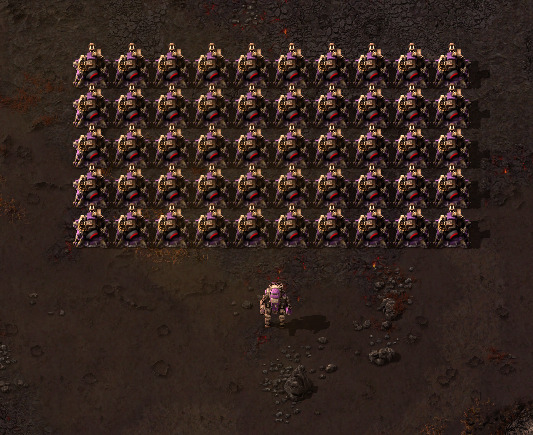
This is a boring solution. I wish it didn’t work. It was the first thing I tried, and afterward I thought … well, what was the point of that? I don’t have a good solution to what you’d want to do to stop this from working, but I do think this is sort of bad design, since it’s a “more dakka” solution. I’ve also seen that you can build a tank and take one out with a single uranium shell, which is even worse design. What I wanted was a fight were I needed to use poison capsules, land mines, strategically placed turrets, etc., some kind of mixed-asset offensive package, and what I got was fifty turrets in a stupid grid. I really do try to not be one of those players that optimizes myself out of having fun, but it’s hard to motivate myself to do something the pointlessly hard way when there’s something simple, easy, and foolproof.
The other thing about demolishers is that they have their own territory, and that territory never changes. This means that if you want to expand beyond a relatively modest starting patch, you need to kill them … but unless you’re going for a megabase, you don’t need to kill more than three or four of them across the entire time playing the game, and since they only attack if you build in their territory, those worm encounters become like 1% of the Vulcanus experience.
I would have liked if the worm territories changed. I think it would have been cool if they fought each other for dominance over an area in a way you could capitalize on, or if they would expand into places that no one had claimed, or places a dead rival had left behind. It would have been cool to require the player to build up some do-nothing machines or other infrastructure to keep the worms back, like a sort of “build this at the edge of your territory to be in constant motion to convince the worms that it’s occupied” type of thing. But instead, you just kill the worms and that’s that, you never see them again unless you go hunting them. According to my end-of-game statistics, I killed 8 small demolishers and 2 medium demolishers, which was probably 5 more worms than I needed to kill, since I ended up with a lot of empty space I didn’t do anything with.
So overall, Vulcanus is the weakest of the planets for me, and I think that’s at least partly down to the under-use of the worms and the simplicity of the “new” mechanics.
Fulgora
Fulgora contains the ruins of a vast civilization, and there are no resources except the heavy oil between islands and the scrap that’s left behind. Solar is terrible on Fulgora, but there are lightning storms at night, and lightning towers can collect it into accumulators to power your base.
Scrap gets “recycled” into a bunch of different things, and so it quickly because a nightmare of sorting things out, dealing with excess products, and turning complex materials into simple ones. There are no iron plates, those need to be recycled from iron gears. There are no copper platers, those need to be recycled from copper wire. Blue chips, which in any other circumstance need to be jealously guarded, are found in abundance.
I found this to be great fun. The challenge is certainly unique, turning the production chain on its head, but it has a nice “ramp” to it, as first you get a pile of crap, then you turn it into things, then you uncover excesses that are gumming it up, and the problems keep coming, but they usually come after you’ve solved some other problem.
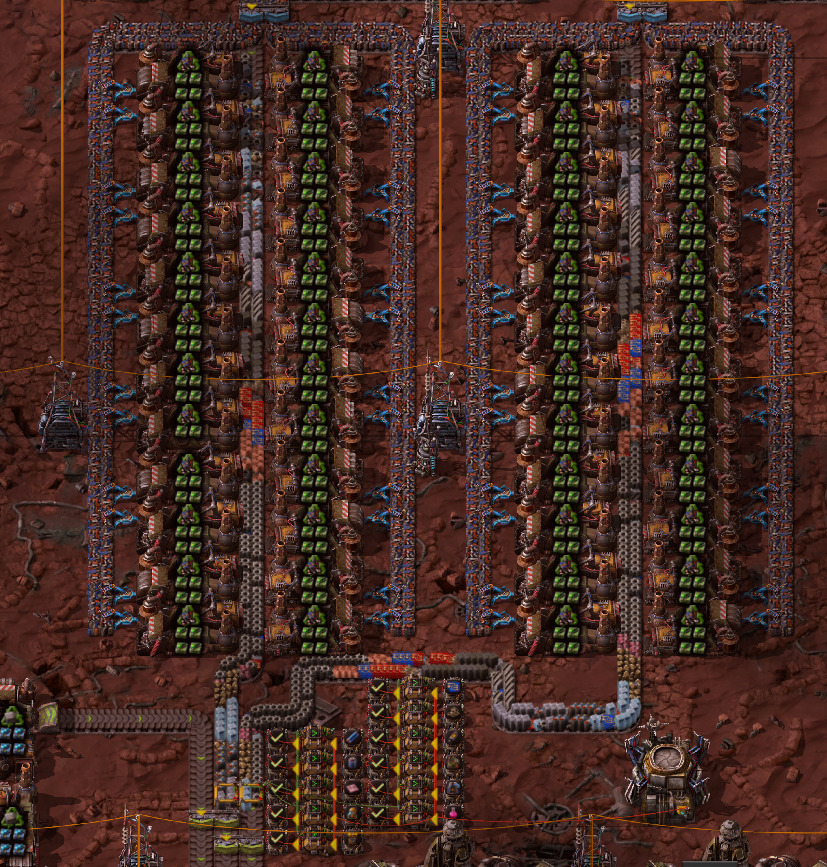
When I started, I did a sushi belt (ed. – a sushi belt is a belt that contains multiple unsorted good, controlled by circuit conditions which allow certain limits of each item to go by, named after conveyor belt sushi restuarants), which was good enough for the short term and got me all the basic technologies, but ran into all the problems that come with a sushi belt, and switched over to a belt-based sorting system of splitters that could handle two full green belts of scrap input.
There is, for me, one big miss on Fulgora, which is that the lightning storms are basically not a challenge at all. You set up a grid of substations, each with a lightning rod, and that protects your base. You set up accumulator fields on one tip of the island, and this is a pretty boring solution. If you went to Gleba first, you can instead set up heating towers that burn the fuel you get from scrap, but this doesn’t seem like it saves terribly much more space, and either way you need the lightning towers, so I’m not sure it’s worth anything, and I never implemented that plan.
One of the other big challenges of Fulgora is that it’s a set of islands, and there’s no way to place anything on the oil sands. Additionally, there are two types of islands, one with a fair amount of space and minimal scrap, the other with tons of scrap and almost no room. In theory, this encourages a rail world, but in practice, the first island I plopped down on was the one I stayed on the entire time, and my rail network, such as it was, extended to only two of the smaller islands to guarantee all the scrap I would ever need. I think I rolled high on one of those islands: 63M scrap is a ton, but that’s what I ended up with on default settings. With the drills from Vulcanus, expected output is double that, and with the legendary drills I can now produce, it would be 787M. There’s simply not a need to place rails elsewhere.
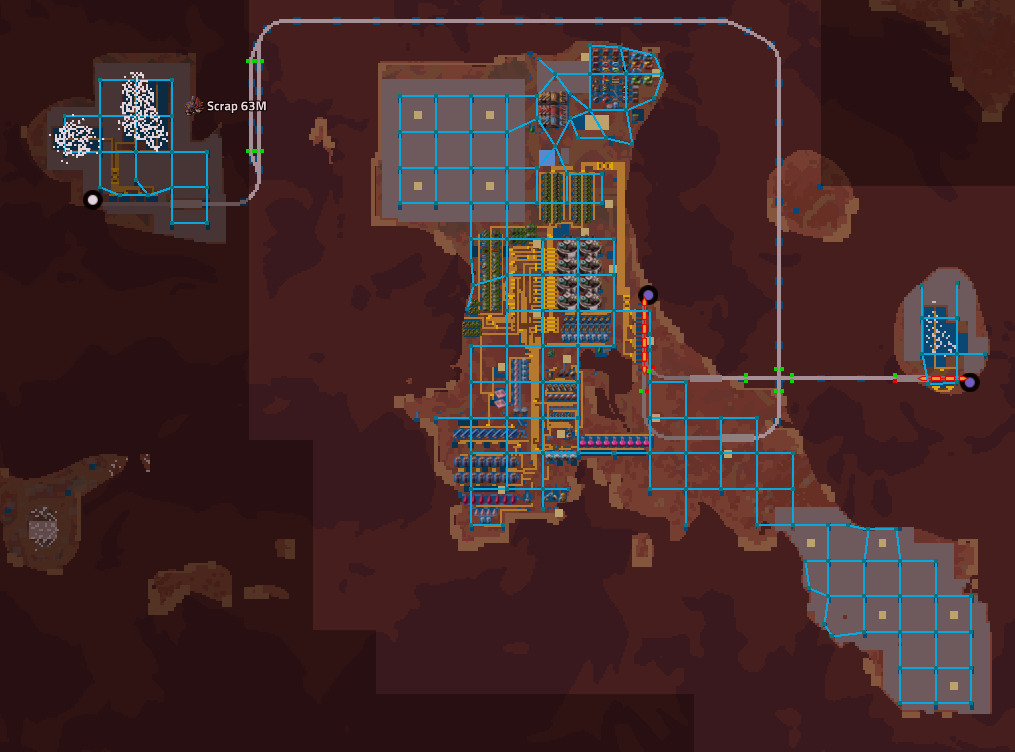
I do feel that Fulgora would have benefitted from some enemies of some kind, either those that lived on the oil fields, so you’d have to build defenses on the edges of the islands, or some kind of robot enemy that you needed to kill to take islands from. Given the setup of an abandoned high-tech planet, and the electrical weapons you unlock there, it would have been nice to have some reason or chance to use them. I’ve definitely played Factorio scenarios with bot opponents and buildings that can be captured after the AI’s defenses have been breached.
Still, the scrap sorting puzzle was a good one, with many solutions, and Fulgora was a ton of fun.
Gleba
Gleba is a swampy fungi planet. There are no conventional resources except for stone, and pretty much everything else is derived from two plants, jellynut and yamako, that get broken down.
The main mechanic of the planet is spoilage, where materials break down over time. Jellynut and yamako last for about an hour, the products you get from them are much less, a material made from both of them, bioflux, lasts a lot longer, and nutrients, which are fed to the new building, the biolab, last hardly any time at all.
Spoilage is cool because it requires a very different mindset. Normally in Factorio, you’re building up big buffers to minimize downtime. On Gleba, you want as little buffer as possible, just constant rivers of materials flowing by to be as fresh as possible, because if anything stays still for too long, there’s a chance it’ll spoil, which will stop the machine trying to take the ingredient, which can create a spoilage cascade.
My initial plan was to have some kind of circuit-based just-in-time system, where every machine would be monitored in order to see what ingredients it needed, and everything would be made fresh-to-order.
I ended up not doing this, mostly because demand stays relatively constant, and where it doesn’t stay constant, you can just eat the spoilage costs. There’s so much abundance that you really don’t need to care about half your crops going to waste.
The other reason I didn’t end up going with this is because unfortunately, the “river of goods” solution has essentially no complications to it, and you can simply dump everything into a recycler/incinerator at the end. In some of the Factorio overhaul mods, this concept is called “voiding”, a way of dealing with byproducts, and if you make voiding easy, you essentially remove a logistical challenge, which means less gameplay. I kind of get why they made this easy, but … I don’t know. I did kind of want something that would require a big, complicated solution, a factory that dances on the edge of clogging itself up.
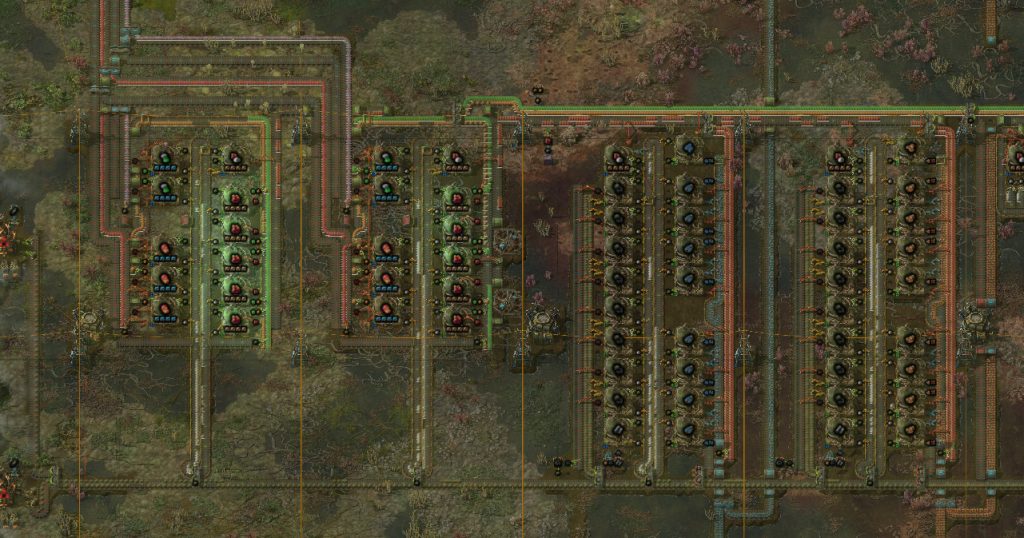
I ended up with a completely belt-based system, with a belt of jelly and mash, then a belt of bioflux, all nutrients made on demand, and production lines in defined blocks. The final build does 520 science/minute, which becomes 2Ks/m with full-prod biolabs, most of which goes into the trash, since it’s not actually consumed all the time.
One of my favorite little puzzles of Gleba was the metals, which are produced with bacteria that spoil in a minute, becoming ore. There’s a process, with bioflux, of having bacteria make more bacteria, but if the bacteria ever stop flowing (if, for example, you have enough ore), then they spoil and die, and the whole production line stops. So you need to build in a little kickstart system that will inject new bacteria if it’s needed, and I found that to be delightful to work on.
The other major thing on Gleba are the enemies, which are pentapods. Pentapod eggs are necessary to make biolabs and science, but after you have one, you can set up breeding, which is dangerous given they can make more of themselves, but definitely the way to go. There are three forms of pentapod, all with their own weaknesses, and …
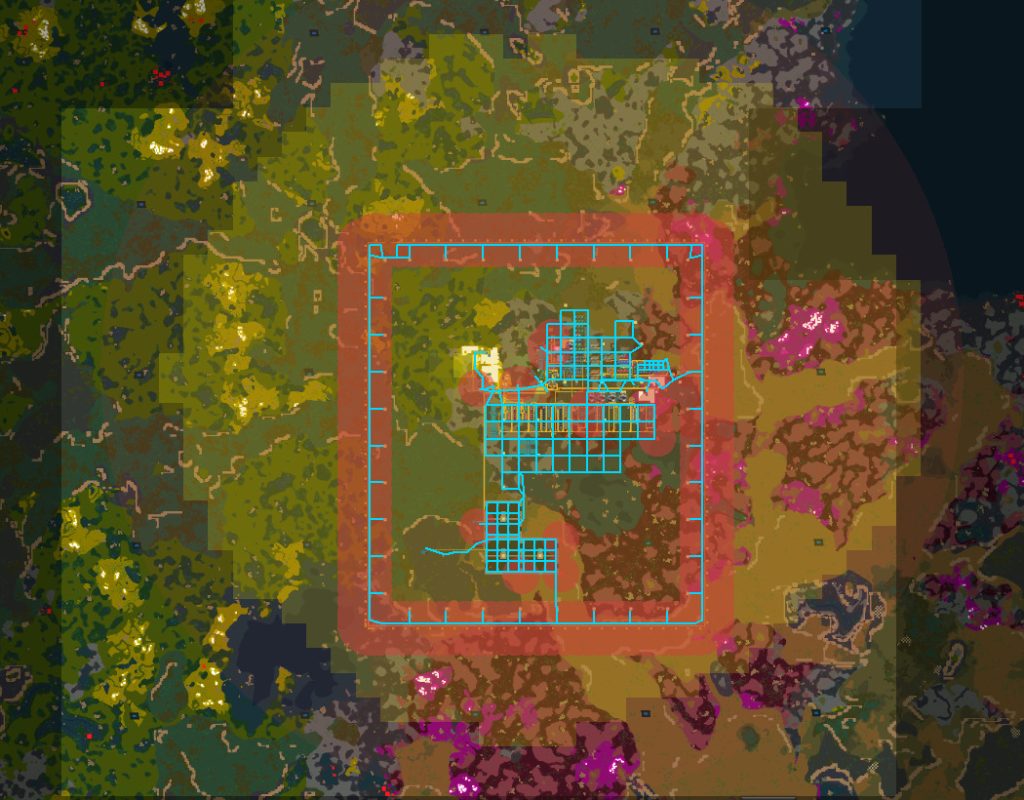
Look, I went to Gleba last, but I put up a defensive wall fairly early on using only materials that I had gotten from Gleba, and then basically never had any cause to think about the pentapods again. Because I slapped this down with blueprints, it took all of ten minutes, most of which was spent fixing the kind of scuffed corners (skill issue). So I would say the amount that I actually got to experience the pentapods was pretty minimal. I also shipped in four artillery turrets that are crowded around a box of ammo, supplied by site-made shells using imported tungsten, and the circle almost entirely contains my pollution cloud, so in theory it’s just an easily solved problem.
It might have been different if I had gone to Gleba first, I don’t know and can’t say without actually doing that, but I would have liked a little more of a challenge, and this might be where being a veteran hinders me.
Overall, I really enjoyed Gleba, the mechanics were new and unique, the little puzzles inherent in design were interesting, and I thought that overall it had the best art direction of the four planets, which is saying something, because I think they’re all great on the front.
Aquilo
On every other planet, a “cold start” is possible, building up from just what you find laying around. Aquilo is different: it’s a planet with ammonia oceans and some scattered liquid vents, and part of the point of it is that you need materials from outside, including anything made from iron, copper, or stone. You can’t softlock on other planets, but you can softlock on Aquilo.
Aside from requiring pretty solid planetary logistics, Aquilo’s main mechanic is heat. It’s cold enough there that bots don’t work very well, and everything has to have a heat pipe near it for it to function, including pipes and belts. To heat up a heat pipe takes either nuclear, fusion, or the heat towers that burn up fuel, and if the heat ever stops flowing, everything will seize up, requiring heroic efforts to get running again.
There’s not all that much to Aquilo. You pull up slurry from the ocean, split it into ammonia and ice, use them together to make ice platforms, import concrete, and then combine oil and ammonia to make rocket fuel, which is used to both launch rockets and to toss into heating towers for power and heat to keep everything running.
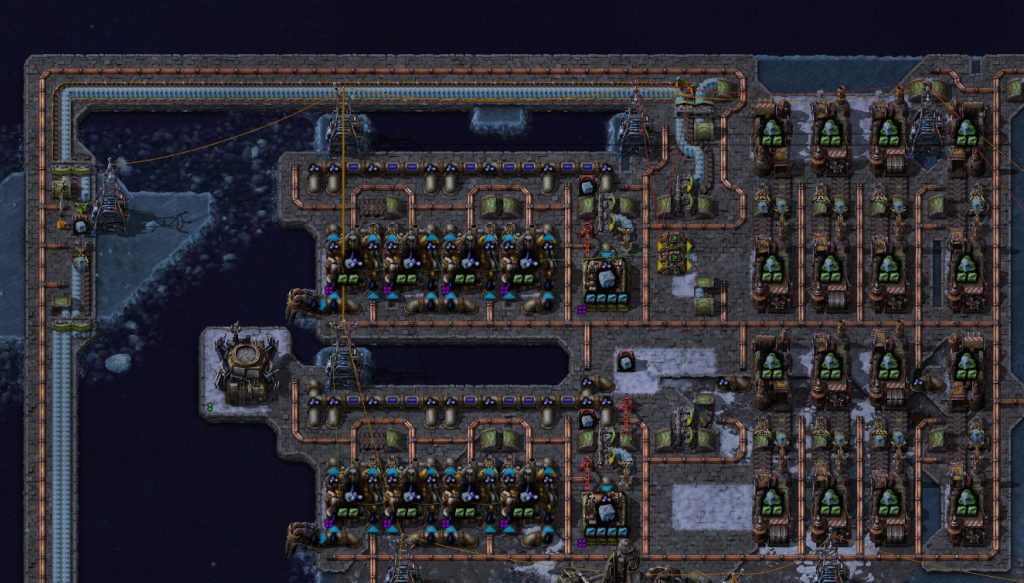
The science pack is easy, though it require imported holmium plate, and my entire 200 science per minute production line was run off a tiny cluster of buildings that would have been pretty trivial to expand.
It seems to me that Aquilo is at least partly inspired by Seablock, an infamous mod where you start with almost nothing on a tiny island that you have to expand with the mineral sludge you dredge up with an offshore pump. But Seablock is a very long mod, one that typically takes hundreds of hours, and here … well, there are a handful of challenges, and they’re not all that challenging. I think I could probably list them out now.
- Making ammonia also makes ice. You can void excess ice through repeated recycling, but ammonia can’t be voided except by combining it with crude oil to make solid fuel, which can then be put in an incinerator. I solved this problem with a simple circuit condition.
- Science and some crafting uses coolant, which must be cooled back down after use. If you just keep making coolant, eventually the system will seize up, since you won’t be able to put more hot coolant into the system. But because this is a lossy cycle (you lose half the coolant) you can just hook a pump up to a tank and only inject more hot coolant into the system when below a threshold.
- Outposts need their own heating for the pumps to work, and those outposts are, on default settings, quite far away. This requires setting up a self-sufficient little heating module that’s either serviced by train or which runs entirely with materials found at the outpost. I ended up doing two different modules, one for oil outposts and the other for everywhere else … but I never actually had to use them, because there were sufficient resources for tens of thousands of resources right next to the starting area.
As the “final boss”, I am underwhelmed, and even as one of four planets I find myself a little underwhelmed. I don’t know how much postgame stuff I’m going to do, but I can’t see that there’s going to be much challenge in going large on Aquilo, except that I might have to build another ship for moving in materials (as currently I have a single ship that makes a circuit of the solar system for materials and also handles shipments of science).
There is also, again, a lack of enemy. Once the rocket fuel setup was done, I had a single scare when ammonia backed up and stopped ice production, which shut down the water chem plant, which killed the turbines and stopped power to the entire base. But that didn’t even freeze anything out, and it was fixed pretty easily from a restart module I’d built earlier, and after that, the ammonia issue was fixed to never have that problem again. If the cold is the enemy, it’s not enough of one for my tastes.
Integration
With each planet you conquer, you get a new science pack, which opens up new technologies, and in theory you, can use them on other planets. These buildings are very powerful, and so there’s some incentive to return to old factories, rip up old designs, and install new ones using the better buildings.
I did eventually do this, but I’m not sure how much I actually needed to. My furnace stacks were replaced by the foundries from Vulcanus, supplies by a hauler ship exclusively for calcite, though I did make an abortive attempt to just harvest calcite from space using a stationary space platform.
(I made four of them before giving up on the project, and found out only later that asteroid spawn rates depend on how many chunks large the ship is, so the ideal build has asteroid collectors on very long arms, and there’s nothing in the game that tells you about the asteroid spawning thing, so … whatever, it’s opaque and very gamey hidden stuff, of the kind that I hate.)
I replaced my circuit production areas with the EMP, which saved vast quantities of resources and also made more circuits at a much faster rate within the same blueprint. I upgraded most belts to green.
I didn’t end up using the biochambers much, in part because they need nutrients to run, and 50% prod with more module slots is great, but not so great that I wanted to set up a biter egg farm that could potentially blow up in my face.
Cryochambers just came too late for me to implement them anywhere, though I probably would if I kept playing to the megabase stage, or if I’m gunning for an achievement that requires updating Nauvis.
So I think, strangely, when considering how the planets impact each other, they … kind of don’t all that much? Yes, having foundries on Gleba means that you can make all your belts and things at a fraction of the cost, but how much doesn’t that really impact anything? It meant that my ore production areas could be smaller, I guess. Is that worth anything? I kind of don’t think so, if I’m considering the main gameplay to be in terms of design and decisions. Foundries saved me from having to lay down a furnace stack. EMPs saved me from having to have expansive red circuit lines to get the blue chips necessary for rocket launches.
Ideally, I would have liked one or two killer techs that mostly work through combining each planet’s “thing”. Like imagine that there was a combination recycler and foundry that melted down whatever was put into it, giving you molten copper and iron in exchange, creating a whole new kind of problem in exchange for … I don’t know, much much faster recycling, or less loss from recycling, or maybe a recipe that allowed true voiding. Or if you went to Gleba and then Vulcanus, and were able to bring biochambers that would allow the cultivation of some new specimen specific to that environment, maybe something that would allow better plastic production, or could pull water out of the air, both of which are kind of a pain in the ass on Vulcanus. Couldn’t there be some kind of new bacteria swimming in the oil sands of Fulgora? Not something that would trivialize any challenge, something that would be a reward for having two flavors of research from two different planets. Ideally, there’d be six of these in total, allowing for each pair to benefit each other pair, but at that point I start to feel like I’m just asking for new content.
I cracked my game back open to check the tech tree, and all the Aquilo techs require all three planets. The are two techs that require mixed packs: Rail Support Foundations, which simplify rails for Fulgora, and Railgun Damage, which increases the power of the railgun. That’s it. This screams missed opportunity to me.
So in terms of how the planets and their mechanics interact with each other … I would say that they mostly don’t, which is a bit of a shame. The biochamber in particular requires nutrients, which makes it effectively unusable on Vulcanus and Fulgora … unless you’re shipping in heroic quantities of bioflux, I guess, though I don’t think that I could ever see myself doing that. I guess maybe on Vulcanus, which has the aforementioned plastics problem? But it feels like the kind of thing that would mostly be done for a stunt rather than because it was actually the right thing to do. And potentially on Nauvis, but it does seem like a megabase thing to do, rather than normal play. I will have to do the math, this too might be a skill issue.
(Real quick: 1 Bioflux makes 8 nutrients in a standard biochamber, which is 12 with prod, which is 24 MJ. A biochamber consumes 500kW, so with no spoilage nutrients allow 2 crafts of the 2 second oil cracking recipes, which means that every Bioflux can, at most, turn 960 heavy oil into 1080 light oil rather than the 720 light oil it would normally crack into. But obviously since the Bioflux has to be shipped in, it ends up being less than that. This is obviously more effective than shipping over oil itself, but … man, I don’t know, this seems very weak, even with adding in productivity to other steps. I guess the use case in Nauvis, where you’re in theory shipping Bioflux anyway in order to feed captive biters, but that’s still premised on an oil shortage that I never actually experienced.)
I do also want to say that quality had very little impact on my play. I tended to carry around some high quality quality modules and use them when crafting infrastructure, but in most cases it just wasn’t much to write home about. It’s most important for the ships, and for personal stuff, but it never felt that important.
And finally, I do want to give a shoutout to how easy and effective remote viewing was. One of the things I’m going to eventually do, after a Factorio break, is the 40 hour achievement run, and I have to imagine that a lot of that is just landing on a planet, doing the unlocks, building a rocket to get back, then having starter bots do all the actual base building for me, which is pretty cool.
Conclusion
Space Age took me about 140 hours, and I would say that about 10 of that was idle time while I was waiting for legendary ship parts or for a buildup of materials. The Jacknape-class ships have an issue with ammo production where they can more or less keep up with rockets, but the belt buffer goes from the front of the ship to the back, meaning that it empties from where it’s needed most, rather than emptying where it’s needed least, and yeah, having a fully stacked buffer takes a hot minute of waiting. Similarly, the quality module I made works over sufficient time scales, but especially while waiting on quality quality modules, there’s a real temptation to just leave it running rather than actively playing.
130 hours for a veteran player is a long time for an expansion, much longer than I would have expected, even knowing what I knew about the expansion going in. Some of that time I don’t count as expansion time, like all the parts where I was just doing normal Factorio stuff, and I did end up building adapted malls on each of the planets, which added on more time that could have been cut out by making an effective blueprint the first go-around, and which I don’t really count as expansion time, because there’s not much that’s unique about making the new malls. But even if I’m arbitrarily cutting things out, that’s still a ton of time.
Overall, I’m extremely happy with it, and I think I’ll be more happy with it once there’s another round of iteration, QoL, changes based on feedback, and modding. The modding scene for Factorio is really really good, and I have to imagine that the expansion is only going to make it better, particularly some of the changes that were made to implementation.
But I do think that it could have been more, and maybe this is just coming from a guy with more than a thousand hours in this game and multiple overhaul mods under his belt. It’s very possible I would have had a better time with it if I’d chosen a higher difficulty, though of course that’s very hard to know ahead of time. Certainly there were some design misses for me, and at least some of that is because I have enough experience that I can fix things with circuitry, plan a base that doesn’t immediately become spaghetti, and see the deadlocks coming. I’m not saying that it wasn’t hard, because parts of it certainly were, and I’m not saying that I made a bunch of perfect bases with no major flaws, because there were designs that needed to be ripped out and belts that needed to squeak through. But I think I would have preferred more complexity, more problems, more more more, and I’ll have to hope that mods can give it to me.
All that said, this is the best expansion I’ve ever played, they put a ton of work into making sure that every planet was truly different from the others artistically and mechanically, and it’s a 10/10 from me.
(I do plan on getting all achievements … eventually. The “win in 40 hour” achievement seems very doable, and that’s the hardest of the lot, though the others might take some significant time. It took me multiple years to finally getting around to doing the last green chip achievement, so I’m in no rush.)
If you have found a spelling error, please, notify us by selecting that text and pressing Ctrl+Enter.